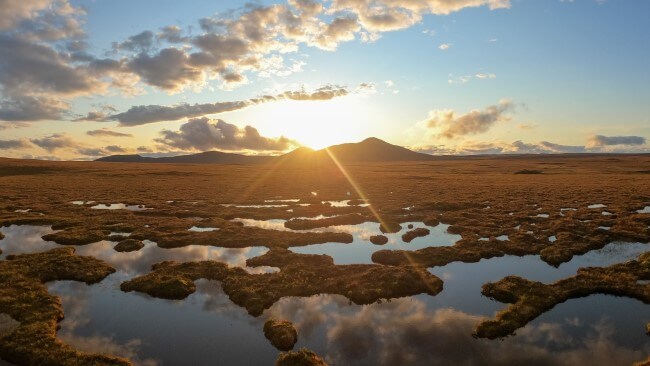Cocktail Queries: What Is Peat, and Why Is It So Important to Scotch Whisky?
Photos via Unsplash, K B.
Cocktail Queries is a Paste series that examines and answers basic, common questions that drinkers may have about mixed drinks, cocktails and spirits. Check out every entry in the series to date.
If you’ve ever read about scotch whisky, or just had the misfortune of sitting next to a particularly gabby whisky geek at the bar, then you’re likely at least passingly familiar with the term “peat.” You may have heard whiskeys described as tasting of peat, or simply labeled as “peaty,” but to the average American whiskey consumer who hasn’t dabbled extensively in scotch, the truth about peat may be a bit more complex than one realizes. The reality is this: Peat is an extremely important component of the scotch whisky industry, but it’s not an automatically necessary one. There are scotch whiskies that can’t be made without the use of peat, and there are whiskies that would be impossible to produce while using peat. It’s a symbol of the scotch whisky industry, and a tool, but simultaneously it’s not one that should be seen as defining the scotch whisky world by any means.
So with that said, if you’re an American whiskey fan who is curious about how exactly peat is used, and what it brings to a spirit, let’s dive into a working definition of why it’s so important.
What Is Peat, and How Is It Used?
Peat, in the simplest terms, is the product of decayed vegetation and organic matter, which forms naturally in environments with standing water and acidic soil. The process of very slow decomposition forms the dark, earthy substance that becomes peat, which forms a base layer in various biomes of the U.K., in Scotland, Ireland the England–areas such as bogs, moors and quagmires. It’s a very slow-developing substance, the product of thousands of years of undisturbed decomposition. Various plants grow upon peat soil in these areas, including the common heather for which the Scottish moors are famous.
For thousands of years, people living near these sources have turned to peat as a readily accessible source of fuel. After being cut out of the ground, peat is stacked and dried, and can then be burned as a slow-burning substitute for firewood. Many generations have subsequently heated their homes or cooked food over peat fires.

A typical Scottish peat bog.
However, peat is more famously known as a fuel that has been used in the whiskey industry, especially when it comes to producing a strongly flavored style of malted barley. This “peated malt” is produced by taking barley that has just finished the malting and kilning process, and then adding a further immersion in smoke. Peat is burnt, and the smoke wafts over the malt for up to 60 hours, infusing it with the flavor of both the smoke and the vegetal notes of the peat itself. Note, however, that not all peated malt is the same–depending on the intensity of the smoke and duration of exposure, the resulting malt may read as only lightly or intensely smoky. This intensity is measured in ppm of phenols, highly aromatic chemical compounds.
In short, peated malt is assertive–it doesn’t play around, and it’s arguably the most intense malt flavor profile out there. In a scotch whisky, it proves campfire-like wood smoke, which may range from sweet to predominantly sour, and it also likely provides “medicinal” flavors reminiscent of vegetation, seaweed, iodine and salinity. At the same time, however, peated malt can also be spicy, sweet and only mildly smoky, depending on its treatment.
Distilleries must therefore decide how much peated malt to use in a single malt scotch whisky, depending on how prominent they want those flavors to be. Some of the most smoke-forward scotch whiskies are made with mash bills of 100% peated malt, essentially embracing the soul of that flavor and throwing caution to the winds. Others use only small amount of heavily peated malt–just a few percentage points–to add a background note of smoke or earthiness for the sake of complexity.
Which Distilleries are Known for Peated Malt Whisky?
One of the most common misconceptions about the scotch whisky world is that all scotch–or even most scotch–is aggressively or demonstrably “smoky” in flavor and aroma. This is an enduring mistake that consumers make, owing to the fact that several of the most famous single malt scotch whisky brands available in the U.S. are indeed heavily peated, and thus very smoke-forward. But if anything, these malts are really the exception, rather than the rule. The use of peated malt is actually uncommon in the biggest of the scotch whiskey regions in terms of production, Speyside, and you subsequently won’t find those peat malt flavors in single malts from companies such as Glenlivet, Glenfiddich, The Macallan or Aberlour.
As you travel westward in Scotland, however, the presence of peat steadily becomes more common. It’s used semi-widely in Highland malts such as Oban, where it contributes a solid background of smokiness that doesn’t overtake the rest of the flavor profile–but at the same time, you still won’t find those smoky flavors in famous Highland brands such as Glenmorangie or Glendronach.

Some common Islay malts.
Where peat really shines is on Islay, the large island off Scotland’s west coast that is home to some of the country’s most famous distilleries. These include names such as Laphroaig, Lagavulin, Caol Ila and Ardbeg, which are all known for having drams that are overwhelmingly peaty/smoky to many palates. These are the definition of “acquired tastes,” as many drinkers react to them with either love or hate on first inspection, but trust me when I say that they have a tendency to grow on you. Likewise, even on Islay it’s not always an all-out assault of smoke and brine–distilleries such as Bunnahabhain or Bowmore are known for taking a more measured approach toward peatiness, and even make the occasional malt without any peated malt at all.
Nor is it necessary for you, the consumer, to progress straight to drinking neat Islay single malts, which can be a bit daunting if you haven’t quite developed a taste for them yet. These smoky malts actually function wonderfully in a variety of cocktail applications, sometimes adding just a dash of smoke to a drink, or becoming the star of the show in a modern classic such as the Penicillin cocktail. Just keep in mind when you’re drinking that the enticing, sweet smoke flavors you’re experiencing probably began as a lump of decomposing peat under a patch of heather in a Scottish bog. The natural world never ceases to amaze, right?
Jim Vorel is a Paste staff writer and resident liquor geek. You can follow him on Twitter for more drink writing.







































